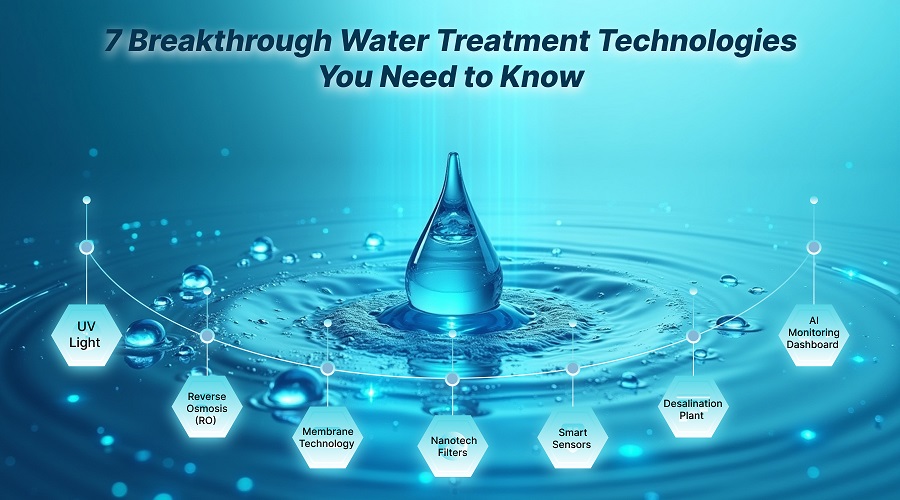Are you concerned about water quality and sustainability? You’re not alone. As populations grow and climate change strains resources, innovative water treatment technologies are becoming essential. This blog explores seven emerging and proven methods transforming how we purify, conserve, and reuse water. By the end, you’ll understand which technologies could be game changers for communities, industries, and your own home.
Water Treatment Technologies Transforming Global Water Safety
1. Reverse Osmosis: The Workhorse of Purification
Reverse osmosis (RO) is a staple in desalination and household filtration. By forcing water through a semipermeable membrane, RO removes up to 99% of contaminants salts, chemicals, and microbes. Innovations in membrane materials have cut energy demands significantly. High‑performance RO systems are now 50% more energy efficient than a decade ago, making them a top-tier water treatment technology.
2. Advanced Oxidation Processes: Destroying Pollutants at the Molecular Level
Advanced oxidation processes (AOPs) combine ultraviolet light, ozone, or hydrogen peroxide to create hydroxyl radicals that break down stubborn organic compounds and pharmaceuticals. Unlike traditional chlorine treatments, AOPs leave no harmful by‑products. Municipal utilities facing emerging contaminants increasingly invest in AOP systems an impressive leap forward in safe water treatment technologies.
3. Membrane Bioreactors: Compact, Efficient, and Versatile
Combining biological treatment with membrane filtration, membrane bioreactors (MBRs) offer two-stage water purification in a compact footprint. These systems deliver high-quality effluent suitable for reuse in agriculture or industry. Innovations in fouling-resistant membranes have lowered operating costs, making MBRs one of the most efficient and flexible water treatment technologies for wastewater reuse.
4. Electrodialysis and Capacitive Deionisation: Smart Ion Removal
Electrodialysis (ED) and capacitive deionisation (CDI) are rising stars among ion-removal methods. ED selectively removes charged ions using electric potential. CDI uses porous electrodes to adsorb minerals like sodium and calcium. Both technologies operate at low voltage and offer efficient desalination for brackish water. Their modular nature makes them ideal for decentralized or off‑grid water treatment technologies.
5. Solar-Powered Water Treatment: Green and Off‑Grid Freedom
Solar-powered systems are expanding access to clean water in remote areas. Hybrid setups combine solar panels with reverse osmosis or distillation units. In off‑grid schools and farms, these systems provide reliable, chemical‑free water using only sunlight. As solar tech costs drop, expect to see a surge in sustainable, solar‑powered water treatment technologies in developing regions.
6. Advanced Biological Filtration: Harnessing Nature’s Power
Nature‑based solutions like biochar filters and algae based systems are gaining traction. Biochar acts like activated carbon, removing organic pollutants while supporting microbial communities. Algae systems can absorb nutrients and heavy metals and the biomass can support biofuel production. These innovative biological water treatment technologies are combining low‑cost filtration with environmental benefits making them ideal for small communities and eco-conscious industries.
7. Real-Time Water Quality Monitoring: Prevention Through Insight
The best water treatment technologies aren’t just physical they’re digital. Sensors now detect contaminants like lead, bacteria and nitrates in real time. Smart analytics and IoT platforms track system performance, anticipate failures and optimise energy use. Utilities and homeowners can receive alerts, take corrective action, and ensure consistently safe water. This intelligence layer is reshaping how water treatment technologies are managed and monitored.
Why These Advances Matter
- Health & safety: Advanced systems reduce emerging contaminants and pathogens.
- Energy & cost savings: Innovations like RO membranes and AOPs are cutting operational costs.
- Sustainability: Solar, biological, and smart technologies conserve resources and reduce waste.
- Scalability: Modular and off‑grid options bring clean water to underserved communities.
These breakthroughs reflect not just new gadgets but a smarter, more sustainable approach to managing one of our most vital resources.
Looking Ahead: The Future of Water Treatment Technologies
The next wave of innovation is focusing on:
- Lab-on-a-chip sensors: Miniaturized devices that detect multiple contaminants instantly.
- Graphene membranes: Ultra thin filters that promise even lower energy RO.
- AI-driven optimization: Systems that self-adjust based on water quality and demand patterns.
These advances are still under development but could transform water treatment technologies in the next decade.
Final Thoughts
Water scarcity, pollution and ageing infrastructure present complex challenges but advancements in water treatment technologies offer practical, scalable solutions. From solar powered filtration in remote villages to smart sensors in city networks, innovation is reshaping the future of clean water access.
By understanding these technologies reverse osmosis, AOPs, MBRs, electrodialysis, solar systems, biological filters and digital monitoring you’re better equipped to make informed decisions, whether you’re advising a city, running an industrial plant, or choosing a home filtration system.
If you’re a PhD scholar or research assistant exploring innovative water treatment technologies, now is the time to dive deeper. From reverse osmosis to advanced biological filtration, these breakthroughs are shaping the future of clean, sustainable water solutions. Whether you’re working on academic research, industrial applications, or policy recommendations, staying ahead with the latest technologies will amplify your impact.
Start exploring, contribute to innovation, and be part of the change in global water purification.
Frequently Asked Questions
1. What is the most energy‑efficient water treatment technology?
Electrodialysis and capacitive deionisation often use less energy than traditional reverse osmosis for brackish water and are ideal for decentralized systems.
2. How safe are advanced oxidation processes?
AOPs destroy organic contaminants at the molecular level and don’t create harmful chlorinated by‑products, making them very safe when correctly operated and monitored.
3. Can I use solar-powered water treatment at home?
Yes small solar-powered RO or distillation units are available for off‑grid homes, farms, or disaster relief setups. Performance depends on sunlight availability and panel capacity.
4. Is membrane bioreactor (MBR) technology reusable?
Absolutely. MBR systems produce high-quality effluent suitable for irrigation, toilet flushing, or industrial uses helping conserve fresh water and reduce wastewater discharge.
5. How does real‑time water monitoring improve safety?
By continuously tracking contaminants and system status, real-time sensors detect issues early allowing for immediate action and preventing prolonged water quality problems.





Comments